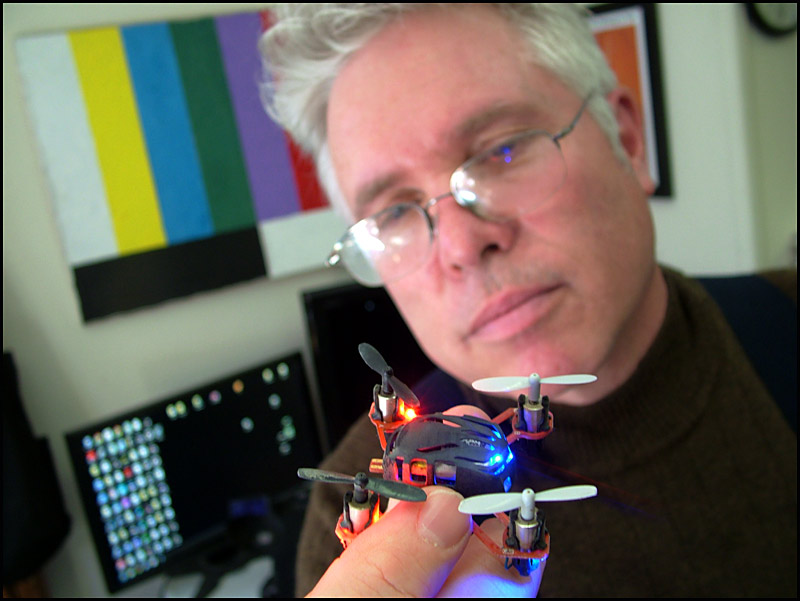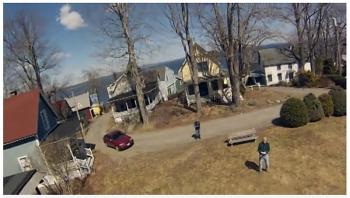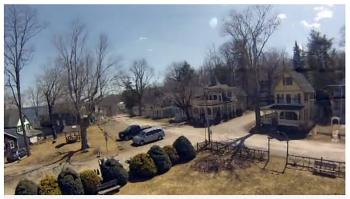Belfast Community TV producers seek out new angles, with a drone
NORTHPORT- Recently Belfast Community TV Station Manager Ned Lightner and Mark Kuzio, a regular contributor, were brainstorming about what to do with their new quadcopter. In several test flights, the radio-controlled helicopter with four propellers and a mount for a video camera had already produced some stunning views of Bayside Village.
When they got better at navigating it, Lighter said he was hoping to do a traveling shot through a covered porch of one of Bayside’s gingerbread cottages with the camera coming to rest above a person relaxing in a hammock.
“Of course, they would know,” he added quickly.
Because when you’re the first kid on the block with a drone, it doesn’t hurt to be clear.
Lightner and Kuzio went in on the quadcopter over the winter. The DJI Phantom, as it’s called, is designed to carry a miniature GoPro video camera — the kind commonly used to capture a downhill ski racer or skydiver’s point of view. It cost around $600, which they fronted because, as Lightner explained, they weren’t quite sure they could justify a radio-controlled vehicle as an expense for the TV station.
Test flights offered a peek at the potential for gravity defying video. Drones can’t operate above the 500-foot minimum altitude for airplanes and helicopters.
“But that’s perfect for us,” Lightner said. “As a videographer, sometimes you want different angles.”
He has several ideas, including low altitude cruises along the length of the Belfast Harbor Walk and Passy Greenway rail trail.
A few years back, using a remote-controlled aircraft like this would have amounted to a clever feat of ingenuity, akin to strapping a camera to a pigeon.
Quadcopters, however, represent a potentially game-changing convergence of cheap aeronautical, video and wireless technologies. Instead of watching it from the ground like a traditional hobbyist would watch a remote controlled airplane, or flying in it like a pilot, a person with a quadcopter can get a bird’s eye view of just about anything, and do it from as far away as their radio transmitter allows.
The Federal Aviation Administration allows “unmanned aerial vehicles” to be used for noncommercial purposes. Though the rule ostensibly applies to hobbyists, Lightner said it would cover any video he shot for BC-TV 2 or Bel-TV 7, the two public access channels he oversees.
Commercial interests are a different matter. The FAA doesn’t permit them today and the agency issues only a limited number of permits for UAV use by law enforcement and first responders. These rules are under review in light of a surge of interest from businesses, civilian search and rescue teams, farmers, filmmakers, tornado chasers, researchers, journalists, real estate companies, roof inspectors and others.
A 2013 video by amazon.com featuring a drone shuttling a package from a distribution center directly to a residence, spawned plenty of commentary on all bands of the utopian/dystopian spectrum, including parodies and references. The service doesn’t exist yet and wouldn’t be allowed under today’s regulations, but the FAA has cracked down on other real ventures and uses.
Lightner said the ban on commercial uses seems inconsistent with the FAA’s general focus on safety, but as a non-commercial user, it doesn’t directly affect him.
What he’s given more thought to are privacy and the connotations of the word “drone.”
Like a lot of people, Lightner’s first exposure to drones came in the form of night-vision videos of suspected American enemies being obliterated by missiles or gunfire.
“I really had to overcome the feeling of creepiness of all the footage of military drones,” he said. “But then I realized RC devices had been around for a long time. So, there’s different shades of these things.”
Likewise, he said, cell phone cameras already allow for much of the kind of invasive photography associated with drones. To this end, Lightner said he considers the Golden Rule as good a guide as any for drone videography.
“If they become more common, I guess there’s a greater chance that [breaches of privacy] can happen,” he said. “It just depends how ubiquitous it becomes.”
Lightner said he hasn’t seen any other drones around Belfast, though recently he and Kuzio met a local resident who had just bought one.
To what degree drones become part of the modern landscape may boil down to whether consumers view them as an evolution of radio controlled helicopters or an extension of more popular devices like cell phones and tablets.
In a promotional video for the latest version of the DJI Phantom, a family relaxing on a beach sends up their quadcopter for an aerial selfie then immediately posts it online. In another scene, a group of young people with quadcopters strapped to their backpacks hikes through the woods as the sun sets in front of them.
Lightner and Kuzio have operated theirs in similarly rarified air, capturing views unobstructed by other people’s drones. At least for now.
“If they were flying over me all the time,” Lightner said, “That would be different, if too many people had them.”
Follow these links for BC-TV video of the quadcopter test flights:
Flying a quadcopter
Flying through Bayside: Spring
Ethan Andrews can be reached at news@penbaypilot.com

































